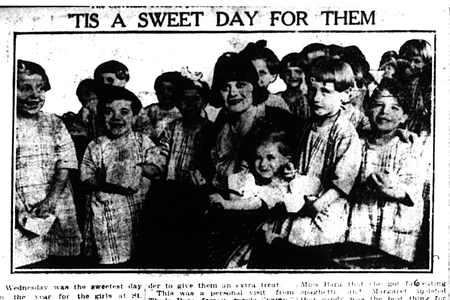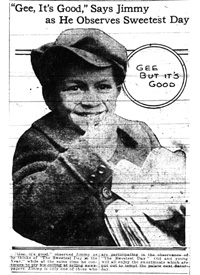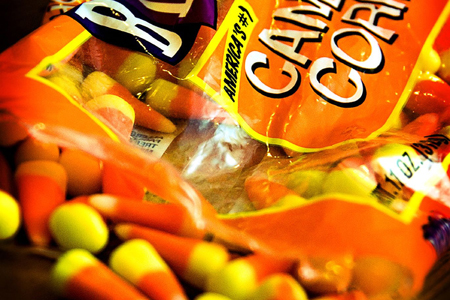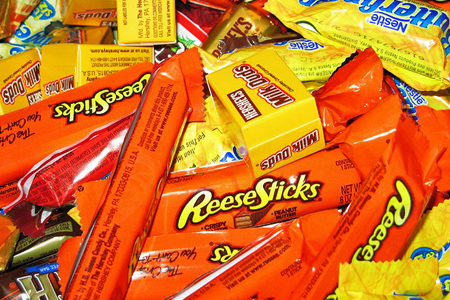Phew. My molars are hurting just thinking about it. If treats are a temptation you hope to avoid, October is the cruelest month. And I can think of only one place in America where your Halloween composure is unlikely to be ruffled by endless quantities of cheap and glittering candies: the past.
Given the ubiquity of candy at this time of year, it is hard to imagine that 100 years ago, Halloween looked quite different from the candy debauch of today.
The biggest difference was trick-or-treating. This seemingly timeless custom is actually a quite recent American invention. The ritual of costumes, doorbell-ringing, and expectation of booty appeared for the first time in different locations throughout the country in the late 1930s and early 1940s. It wasn't until the late 1940s that trick-or-treating became widespread on a national scale. And even then, candy wasn't the obvious treat.
Kids ringing a stranger's doorbell in 1948 or 1952 received all sorts of tribute: Coins, nuts, fruit, cookies, cakes, and toys were as likely as candy. In the 1950s, Kool-Aid and Kellogg's promoted their decisively non-candy products as trick-or-treat options, while Brach's once ran ads for chocolate-covered peanuts during the last week of October that didn't mention Halloween at all.
It took a while for candy to become what it is today, the very essence of Halloween. Going back even farther to the early decades of the century, before trick-or-treating spread across the land, candy didn't have any special role to play in Halloween observance.
For youth, and especially boys, Halloween was the one night of the year when communities generally tolerated pranking, which might range from the clever or playful to the dangerous or destructive. Mailboxes, fences, streetcars, and gravestones were popular targets. The point was to cause mischief, not to gather treats. Halloween also wasn't a gift-giving holiday, which in the case of Christmas and other early candy holidays provided the candy "hook."
While the hooligans were out wreaking havoc, the more genteel would celebrate Halloween with parties. The menus and décor for these early Halloween festivities emphasized seasonal fruits. Pumpkins and apples were especially important. Making popcorn balls and fudge was sometimes part of the festive activities, but if there was purchased candy along the lines of candy corn or jelly beans, it was an afterthought, just a something over there with the nuts and favors.
When candy makers in the 1910s and 1920s looked for ways to grow their fall sales, Halloween barely registered as a potential marketing opportunity, even though they were already using holidays as opportunities to sell seasonal confections. Christmas and Easter were big candy events, already established with their candy traditions by 1900: boxed chocolates and hard candies for Christmas, jelly eggs and molded bunnies for Easter. Lagging not far behind in importance on the candy holiday calendar was Washington's Birthday, to be celebrated with special marzipan cherries and cocoa-dusted logs. But special candies for Halloween? Not a one.
It was during the 1950s that candy made decisive inroads in dominating Halloween. The rise of trick-or-treating made the holiday the perfect occasion for marketing a product associated with children and fun. But the push from candy sellers was met with equally enthusiastic demand. Candy was easy to buy and easy to distribute, making it a convenient choice for Halloween hosts. And as the numbers of trick-or-treaters swelled, candy was also economical. Small, inexpensive candies became popular, and major candy manufacturers began making smaller candy bars or bags of candy corn.
Through the 1960s, it was still conceivable that some other treat might be offered. It wasn't until the 1970s that candy came to be seen as the only legitimate treat. And while the candy industry reaped the benefits, the immediate impetus was not brilliant marketing so much as rising fears that unwrapped or homemade Halloween treats posed risks of tampering and poisoning. Commercial wrapped candy was the only safe choice.
All of which raises the question: What was the candy industry up to during all those years before we had the license and opportunity to indulge in enormous quantities of Halloween candy? It turns out that in 1916, candy promoters did come up with an idea to launch the fall candy season and boost sales and consumption, but it wasn't Halloween. It was a new holiday invention, uniquely American in its entrepreneurial spirit: Candy Day.
October's Original Candy Holiday? 'Candy Day'

Sometime in 1916, the candy people looked at their empty fall calendars and decided what America needed was a new candy holiday, a day to celebrate all things candy, to eat candy with extra enthusiasm, and not coincidentally, to give candy sales a boost in advance of the Christmas holiday season. But the holiday wasn't Halloween. The word went forth from the National Confectioners Association: The second Saturday of October would henceforth be known as "Candy Day."
Candy Day, the day when every man, woman, and child would be urged to forget minor affairs and see to it that someone was sent a box or bag or bucket of candy.
In anticipation of October 14, 1916, the candy trade journals beat the drum to encourage local candy shops to feature Candy Day promotions. Sample signs were published, as well as "articles" that could be sent to local papers extolling the virtues of Candy Day and candy eating:
The true "Candy Day" spirit is apart from the idea of just stimulating a greater consumption of candy. This will naturally follow a national educational campaign exploiting the real food value of candy - pure candy. The "Spirit of Candy Day" proper may be interpreted as a spirit of good will, appreciation and good fellowship.The sentiments were noble. But behind the scenes, the intentions were no secret:
The only motive of the [NCA Executive Committee] is to aid every Manufacturer, Jobber and Retailer in increasing his profits through increased sales on "Candy Day." ...There's no getting around it. Candy Day was an entirely invented holiday with one purpose: to sell candy.
It's simply asking you if you want to make some extra money, and if you do, you are requested to go ahead and push this "Candy Day" idea.
(All quotations from "Nation Wide Candy Day," Candy and Ice Cream July 1916, p. 34-35)
Once the distracting business of World War I was safely concluded, Candy Day became a major cause among many leading candy manufacturers and retailers. Candy Day was promoted with varying degrees of success in 1919 and 1920, and slowly caught on in some cities. But it wasn't until 1921 that someone figured out how to give Candy Day some real traction. In that year, the organizers in Cleveland had a brilliant idea: to launch the day with a high-profile giveaway of candy to orphans and old ladies.
Celebrities were recruited and newspapers alerted to the stunt. It was a savvy maneuver to outflank the public's emerging suspicion of being manipulated by self-serving business interests. Candy Day was re-christened "Sweetest Day," and the promotional emphasis shifted from flat-out candy sales to the finer feelings of romance, gratitude, and generosity.

The Sweetest Day in the year came into being because the founders recognized the eternal tendency of men and women to become so engaged in the rush and whirl of life, and to forget the finer, more appealing things. On this day, next Saturday, steal enough time from the turmoil of routine affairs, to bring a bit of good cheer to those you love. A present, perhaps, and more than that add a loving word - a smile - a kiss.And you might not have known candy had anything to do with the day, until you noticed who was on the Sweetest Day committees, year after year. Confectioners, druggists, retailers, anyone with a finger in the candy pie.
Throughout the 1930s and 1940s, and into the 1950s and 1960s, Sweetest Day continued to be celebrated on the second or third Saturday of October. The emphasis continued to be on the higher sentiments of generosity and charity, and at some point, a "legend" surrounding Sweetest Day emerged:
Legend has it that Sweetest Day was established around 1922 by Herbert Birch Kingston, a Cleveland, Ohio, candy company employee who wanted to bring happiness to the lives of those who often were forgotten. Kingston and others distributed candy and small gifts to orphans, shut-ins and others to show them someone cared. (Hallmark)An enterprising Wikipedia muckraker has unearthed the record for Herbert Birch Kingston in the 1920 census: his profession is listed as "advertiser." In any event, I have been unable to find any other mention of this Herbert Kingston in contemporaneous documents. As for the remainder of this account of Sweetest Day origins in charitable impulses, it is entirely fictitious.
The legend of Herbert Birch Kingston is useful nonetheless. Both Hallmark and the trade group Retail Confectioners International repeat this story on their Sweetest Day information pages. The Kingston myth supports the idea that Sweetest Day is not just another selling opportunity, but what RCI calls an "occasion which offers all of us an opportunity to remember not only the sick, aged and orphaned, but also friends, relatives and associates whose helpfulness and kindness we have enjoyed." Of course, when the retail confectioners say to "remember" someone, what they probably mean is "send candy."
Today Sweetest Day is reportedly observed in just a few cities, including Detroit, Buffalo, and Cleveland. It's not surprising: Halloween is all the occasion we seem to need these days to eat candy from mid-September all the way until Thanksgiving. The candy industry may have lost the battle for Candy Day. But just gaze on those pounds and pounds of fun-size black-and-orange wrapped treats. Halloween turns out to have been the real candy prize anyway.
The Meaning of Halloween-Candy Psychopath Stories
The whole point of Halloween for kids these days is taking candy from strangers. Of course, that's just what we are never supposed to do. To protect children from the dangers of strangers' candies, parents everywhere are on high alert for the menace sometimes known as the "Halloween sadist." You know the one - that psychopath who uses the occasion of trick-or-treat as an opportunity to poison the neighborhood kiddies with strychnine-laced Pixie Stix and razor blade-studded caramels. Every piece of candy is guilty until proven innocent by thorough examination.
And how many children have been harmed by randomly poisoned trick-or-treat candy? Approximately zero. It turns out that the Halloween sadist is about 1 percent fact and 99 percent myth. One California dentist in 1959 did pass out candy-coated laxatives, and some kids got bad stomachaches. But instances over the past 40 years where children were allegedly harmed by tainted candy have invariably fallen apart under scrutiny. In some cases, there was evidence that someone (a family member) was attempting to harm a particular child under cover of Halloween. In other cases, poisoning which had another cause was misattributed to candy. Not surprisingly, the myth created its own reality: As the stories of Halloween tampering spread, some kids got the idea of faking tampering as a sort of prank. Despite all evidence to the contrary, the myth persists.
The precise methods of the imaginary Halloween sadist are especially interesting. Apples and home goods occasionally appear in the stories, but the most common culprit is regular candy. This crazed person would purchase candy, open the wrapper, and DO SOMETHING to it, something that would be designed to hurt the unsuspecting child. But also something that would be sufficiently obvious and clumsy that the vigilant parent could spot it (hence the primacy of candy inspection).
The idea that someone, even a greedy child, might consume candies hiding razor blades and needles without noticing seems to strain credulity. And how, exactly, a person might go about coating a jelly bean with arsenic or lacing a molasses chew with Drano has never been clear to me. Yet it is an undisputed fact of Halloween hygiene: Unwrapped candy is the number-one suspect. If Halloween candy is missing a wrapper, or if the wrapper seems loose or flimsy, the candy goes straight into the trash.
Here is where I think we can discover some deeper meanings in the myth of the Halloween sadist. It's all about the wrappers.
Wrappers are like candy condoms: Safe candy is candy that is covered and sealed. And not just any wrapper will do. Loose, casual, cheap wrappers, the kind of wrappers one might find on locally produced candies or non-brand-name candies, are also liable to send candy to Halloween purgatory. The close, tight factory wrapper says "sealed for your protection." And the recognized brand name on the wrapper also lends a reassuring aura of corporate responsibility and accountability. It's a basic axiom of consumer faith: The bigger the brand, the safer the candy.
Ironic, since we know that the most serious food dangers are those that originate from just the kind of large-scale industrial food processing environments that also bring us name-brand, mass-market candies. Salmonella, E. coli, and their bacterial buddies lurking in bagged salads and pre-formed hamburger patties are real food dangers; home-made cookies laced with ground glass are not.
Even sadder that the banishing of jelly beans and weird hard candies to the trash can is the disappearance of the cookies and popcorn balls that used to be trick-or-treat staples. Can we even imagine a time when offering homemade treats to children at the door, even children you didn't know, would have been considered acceptable, desirable even? Yet this was common practice well into the 1950s. The Halloween sadist legends are part of a larger movement in American culture away from our sense that we can do it ourselves. The factory does it better, tastier, safer. In the anonymous Halloween exchange, when we don't personally know that person dropping candy bars in little Petal's bag, it is as though the brand name is the only thing we can really trust. Which is also ironic, since in fact those brand names are not humans, but faceless corporate machines.
It is only in the last few years, with the do-it-yourself and Slow Food movements, that we've seen some real challenges to this market-driven value and a return to the local and handmade. But does this mean we'll see a resurgence of homemade cookies this Halloween? I doubt it - at least not for those anonymous exchanges that are the essence of trick-or-treat. Now that we've eaten the apple of fear and distrust, it doesn't seem likely that we'll change our suspicions anytime soon. Americans today seem quite eager to put their faith in brand names and global conglomerates and to shun old-guard civic institutions like governments, schools, and neighborhood communities. And when it's about the safety of our children, reason easily gives way to hysteria. My scholarly, historical, rational self tells me that psychopaths don't go to the trouble to bake cookies or soak loose lemon drops in LSD. My hovering, nervous, worried mother self doesn't care. Unwrapped jelly beans, into the trash you go.





Reader Comments
to our Newsletter